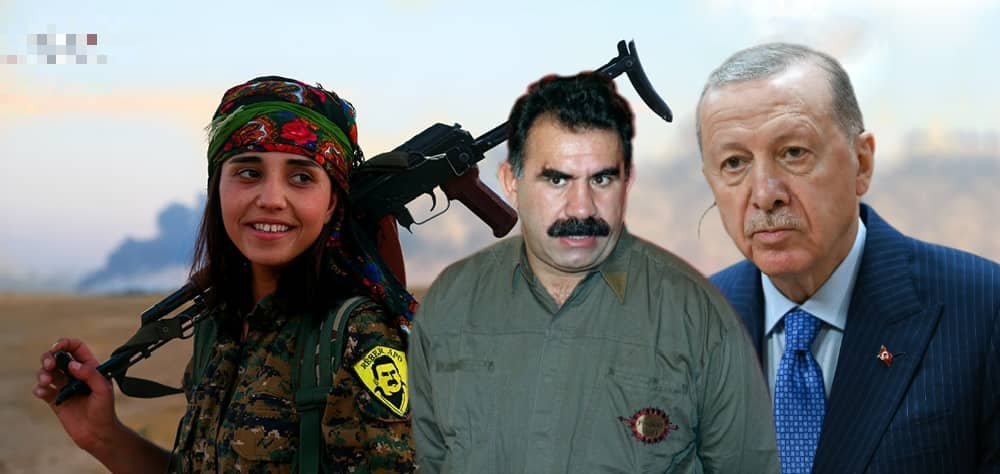Steven Sahiounie, journalist and political commentator
Abdullah Ocalan, the imprisoned Kurdish leader of the PKK, announced a historic call to lay down arms and end a 40-year armed conflict with Turkey. The announcement was delivered on February 27 by his spokesperson, who called for increased freedom for Ocalan who has been in solitary confinement in Imrali island prison near Istanbul, following his arrest in 1999.
President Recep Tayyip Erdogan reacted to the new promise with wariness that comes after 40,000 people have died at the hands of the PKK over three decades of terrorism. Erdogan knows talk is cheap, and he wants to see positive action first. New drone warfare has greatly diminished the PKK’s guerrilla impact, forcing it onto the defensive.
While the PKK headquartered in Northern Iraq, the Kurdistan Regional Government (KRG), accepted the Ocalan announcement positively and promised compliance, the PKK affiliate in Syria denied that the directive to lay down arms applied to them.
Turkey has been a close US ally, hosts a US Air Force base at Incerlik, and is a fellow NATO member. Turkey has felt betrayed by the US after the Obama administration began grooming the Syrian Kurds in the northeastern quarter of Syria, promising them self-administration and funding them with cash, weapons, training, and all other assets needed to partner with the US military in the fight to eradicate ISIS.
Repeatedly, Erdogan called on Washington to break their support of the Syrian Defense Forces (SDF), and their armed wing the YPG, who are a direct link to the PKK. The Turkish pleas fell on deaf ears in Washington. After Trump took office in his first term, he ordered the US military to withdraw from Syria, which would have meant the end of the US support and defense of the SDF and YPG, but the seemingly ‘deep state’ refused to allow Trump’s order to be fulfilled.
In 2011, the Obama administration began supporting an uprising in Syria to overthrow President Bashar al-Assad. The CIA program Timber Sycamore was set up in Turkey to support all the military needs of the armed rebels. Turkey was used as the staging ground of the attack on Syria for regime change, while substantial funding came from Saudi Arabia and Qatar.
Amid the chaos that ensued, the Kurdish population in the northeast saw an opportunity to use weapons against their neighbors, while ethnically cleansing the area in favor of Kurds, who were not the majority. Still, it was a sizable community of the region.
The Kurds formed a civil administration, the Democratic Autonomous Administration of North and East Syria (AANES), which followed the socialist PKK ideology, which was Marxist-Leninist. The US needed ‘boots-on-the-ground’ in Syria to fight ISIS, choosing not to partner with Syrian, Russian, and Iranian security forces fighting ISIS, so Washington decided to partner with the Kurds.
ISIS was finally defeated, but the US remained supporting the SDF and YPG. The US never promised the Kurds a homeland, but only a shared interest to eradicate ISIS. The Pentagon’s 2025 budget has requested $148m for the SDF, while in 2023, they received $160m.
President Ahmad Sharaa, head of the new Syrian government is in the process of establishing new institutions. Sharaa has asked the SDF and YPG to dissolve and become part of the new Syrian national army. The SDF did not play a role in the assault that toppled the Assad government.
General Mazloum Abdi, commander of the SDF, has said they will not disarm or dissolve. Abdi suggests the SDF and YPG remain intact, and under the current leadership, but become aligned with the new Damascus army when it is formed. Sharaa finds this unacceptable, as he envisions a new Syrian army that is under a single command based in Damascus.
SDF spokesperson Ilham Ahmed said, “We need to stick to our weapons because we are fighting ISIS. We will also need reinforcements because it is obvious that in several areas of Syria ISIS has recently become even stronger than before.”
The SDF uses the threat of an ISIS resurgence to justify their continuing need for weapons. But, experts say that while ISIS may exist in pockets, there is no current evidence of a large-scale threat to the region.
In the one and half months that Trump has been in office, he has been preoccupied with trying to end the war in Gaza and Ukraine. Syria has been on the back-burner, but experts believe that Trump will eventually call for the 900 US troops in Syria to be withdrawn. If that happens, it would mark the beginning of the end of the US support of the SDF and YPG. This order would bring General Mazloum and Ilham Ahmed would be forced to make concessions with Damascus and end their dreams of a Kurdish homeland in Syria.
On December 8, 2024, President Bashar Assad was driven from a throne he had sat on for 24 years. Many were shocked at the speed of the two-week armed attack by the HTS, under the command of Ahmed Sharaa, which ousted Assad after 14 years of civil war. The success of the fall of Assad was not because of a special weapon, or a large ground force. The fall of Assad was a multi-national pact among the great powers. The US, Russia, Turkey, and Iran all were players in the regime-change conflict. The US promised Russia they would get a peace deal in Ukraine. The US gave Turkey the green light in Syria, and the US promised Iran’s nuclear facilities would not be attacked by Israel. In collaboration, the HTS marched out of Idlib knowing the great powers were on their side, and the road to Damascus was wide open for a victory.
Following the call to disarm, will the Kurdish dream of a homeland be lost? Will the Kurds be the latest loser in the chess game played out while a new Middle East is born?
Steven Sahiounie is a two-time award-winning journalist.



